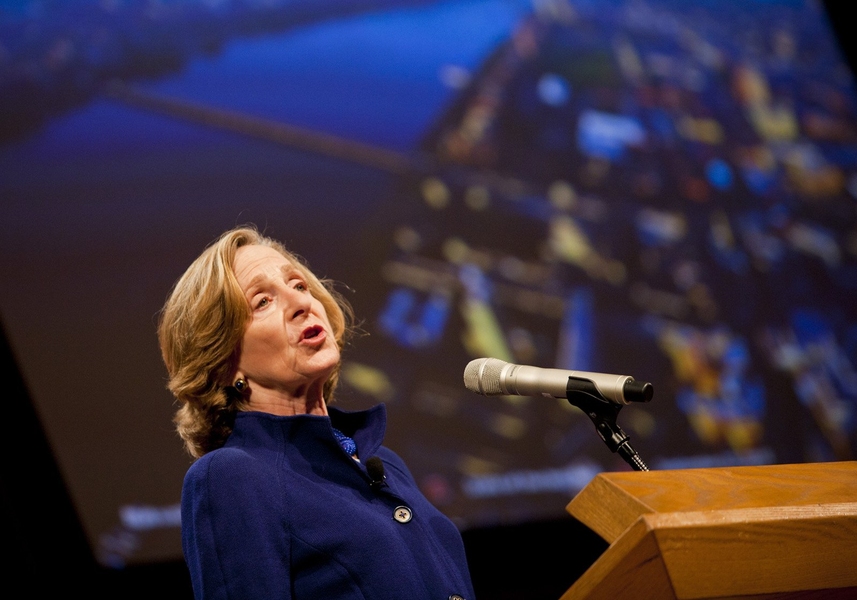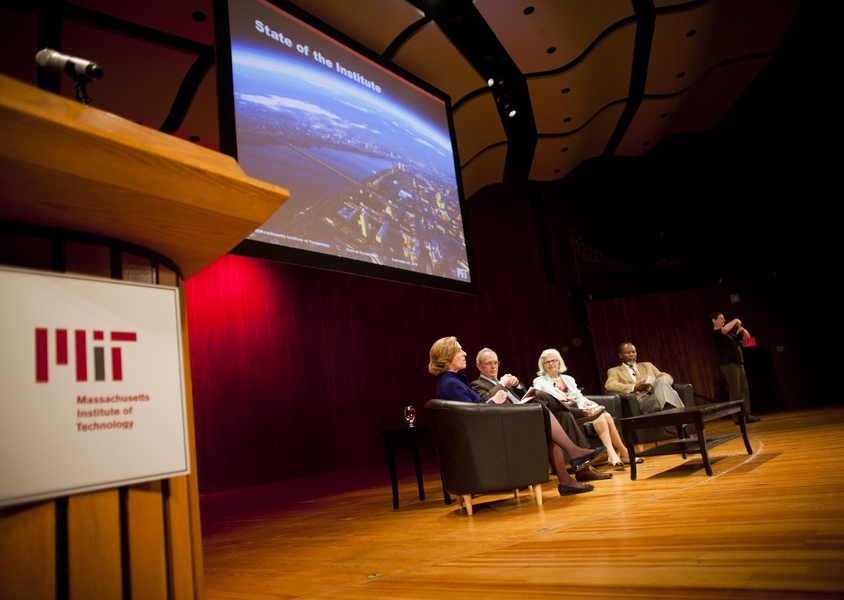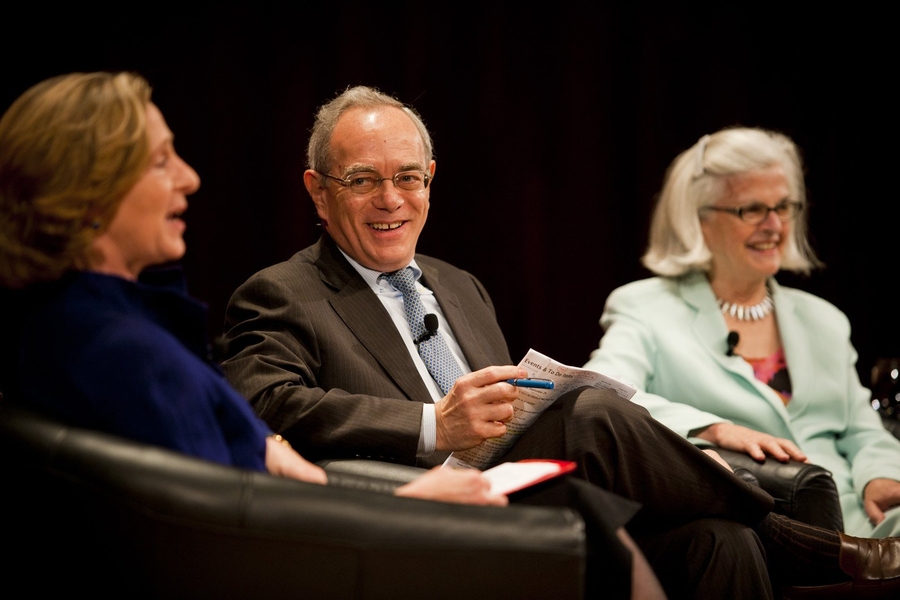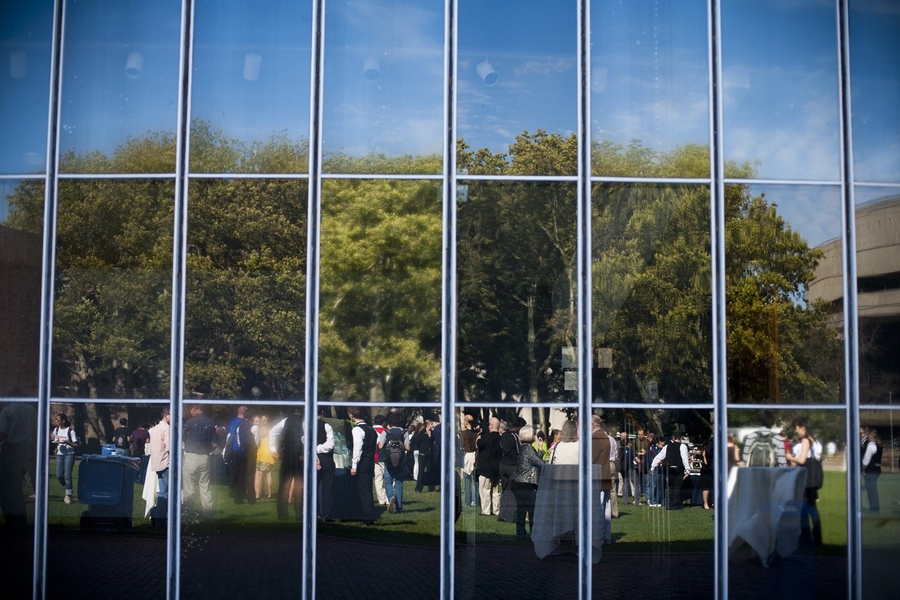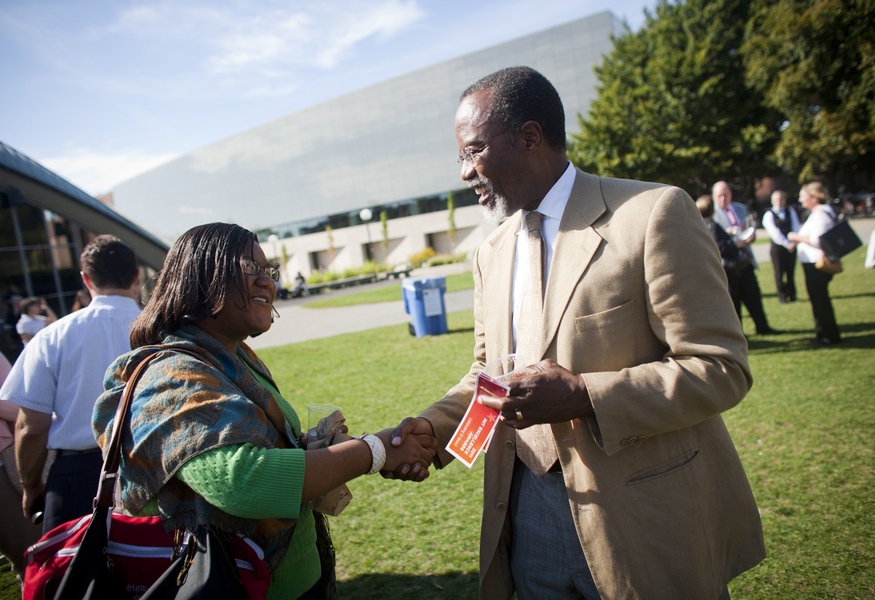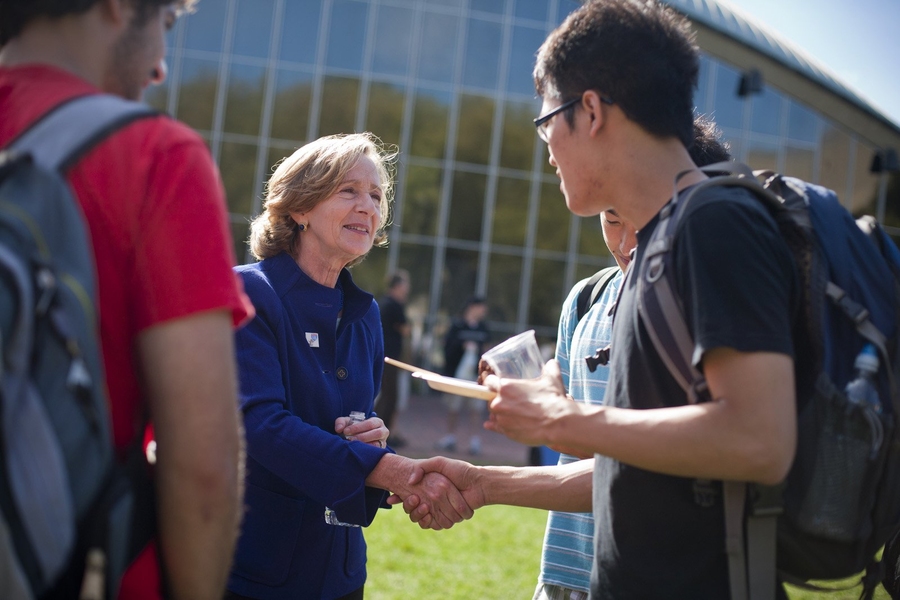MIT appears to have weathered the economic downturn and is in a position to celebrate both its past and its future, President Susan Hockfield reported Wednesday at the annual State of the Institute forum held at Kresge Auditorium.
“We’ve stuck to our mission and preserved our strengths, and I can be reasonably hopeful that the worst is behind us,” Hockfield said in her address to several hundred members of the MIT community. The one-hour forum began with an address by Hockfield, who was later joined onstage by Provost L. Rafael Reif, Chancellor Phillip Clay and Executive Vice President and Treasurer Theresa M. Stone. The four answered questions from the MIT community, some of which had been submitted in advance and others of which came from the live audience.
“This year, we have a lot of good reasons to be celebrating,” Hockfield said, reminding the audience of MIT’s upcoming 150th anniversary celebration set to take place over 150 days starting in January. The celebration will feature events, performances, symposia and a sesquicentennial convocation to be held on Charter Day on April 10. The 150th will also feature an MIT Open House, which will for the first time in decades open the Institute’s labs and offices to the greater Cambridge and Boston communities.
Hockfield stressed that while MIT has a remarkable history to celebrate, it’s equally important to celebrate the Institute’s future — and that MIT can do so thanks to hard work by all over the past two years. She explained that five years ago, the Institute began a “rebalancing” project to figure out how to use its resources more effectively. Because that effort was already underway when the economic crisis hit, the Institute was well prepared to address the crisis. Although MIT had to reduce expenses by about $120 million over fiscal years 2010 and 2011 — a move that involved layoffs — the initial rebalancing efforts helped “save us from making even deeper cuts,” Hockfield said.
Two decisions were critical to the budget-cutting process, Hockfield explained. The first was the decision to preserve need-blind admissions and need-based financial aid for undergraduates. Hockfield noted that of this year’s incoming freshman class, 65 percent come from public schools, 16 percent are the first in their family to attend college and 19 percent qualify for grants from the Federal Pell Grant Program, which helps those students with significant financial need pay for college.
Hockfield said that MIT remains committed to keeping borrowing to a minimum for its students. She reported that less than half of last spring’s graduating class had to borrow for their education, and that those who did had an average debt of about $15,000 upon graduation. The average starting salary for an MIT graduate in 2009, she noted, was $67,000.
The second decision critical in the Institute’s approach to weathering the economic downturn, Hockfield explained, was the decision to continue to recruit and hire new faculty — a move that Hockfield said many of MIT’s peer institutions have not followed. This year, MIT welcomed about 40 new members to its faculty.
Hockfield cautioned that despite reaching, through good financial management, a “prudent and safe” position, the Institute still has a long way to go to recover financial ground it lost during the global downturn. Although the endowment’s investment return for last year was 10 percent — compared to the previous year’s loss of 17 percent — the total value of the endowment rose only just over 5 percent for the year. (The difference stems from outflows from the endowment, which fund the Institute’s general budget, and inflows from gifts.)
Hockfield and Clay reported that even through the financial crisis, MIT continued to receive the support of friends and alumni. Hockfield remarked on the recent $24 million gift from Fariborz Maseeh ScD ’90, and a number of other gifts, which will allow the Institute to fast-track renovations to W1, an undergraduate residence, so that it can open in the fall of 2011. The residence will be renamed Fariborz Maseeh Hall, and it will permit the undergraduate population to increase to 4,500 students, about 250 more students than today’s enrollment, consistent with MIT’s undergraduate enrollment in the early- and mid-1990s.
That project is part of MIT 2030, an ongoing process to renew and repair the physical campus both through major projects, such as the new Media Lab complex, the new building for the MIT Sloan School of Management, and the David H. Koch Institute for Integrative Cancer Research, as well as less-visible upgrades and efforts to make MIT’s buildings more energy efficient. A top academic priority for this effort is to find a location for a future nanofabrication lab, Hockfield said.
Following her address, Hockfield and the senior administrators responded to a series of questions related to future layoffs, cost-saving measures and fundraising efforts. Although Reif said that his team is trying to implement a “more robust budget process” to make sure the Institute has enough funding to meet its obligations and withstand future changes in the economy, he said it was too difficult to predict with certainty whether future layoffs would be necessary.
Stone reported success with “Digital MIT,” a set of efforts designed to modernize MIT’s administrative systems and processes, while Clay reported “extremely positive” reception from friends and alumni in support of the Campaign for Students fundraising effort to raise $500 million in support of scholarships, fellowships and infrastructure support that directly affects student life and learning.
“We’ve stuck to our mission and preserved our strengths, and I can be reasonably hopeful that the worst is behind us,” Hockfield said in her address to several hundred members of the MIT community. The one-hour forum began with an address by Hockfield, who was later joined onstage by Provost L. Rafael Reif, Chancellor Phillip Clay and Executive Vice President and Treasurer Theresa M. Stone. The four answered questions from the MIT community, some of which had been submitted in advance and others of which came from the live audience.
“This year, we have a lot of good reasons to be celebrating,” Hockfield said, reminding the audience of MIT’s upcoming 150th anniversary celebration set to take place over 150 days starting in January. The celebration will feature events, performances, symposia and a sesquicentennial convocation to be held on Charter Day on April 10. The 150th will also feature an MIT Open House, which will for the first time in decades open the Institute’s labs and offices to the greater Cambridge and Boston communities.
Hockfield stressed that while MIT has a remarkable history to celebrate, it’s equally important to celebrate the Institute’s future — and that MIT can do so thanks to hard work by all over the past two years. She explained that five years ago, the Institute began a “rebalancing” project to figure out how to use its resources more effectively. Because that effort was already underway when the economic crisis hit, the Institute was well prepared to address the crisis. Although MIT had to reduce expenses by about $120 million over fiscal years 2010 and 2011 — a move that involved layoffs — the initial rebalancing efforts helped “save us from making even deeper cuts,” Hockfield said.
Two decisions were critical to the budget-cutting process, Hockfield explained. The first was the decision to preserve need-blind admissions and need-based financial aid for undergraduates. Hockfield noted that of this year’s incoming freshman class, 65 percent come from public schools, 16 percent are the first in their family to attend college and 19 percent qualify for grants from the Federal Pell Grant Program, which helps those students with significant financial need pay for college.
Hockfield said that MIT remains committed to keeping borrowing to a minimum for its students. She reported that less than half of last spring’s graduating class had to borrow for their education, and that those who did had an average debt of about $15,000 upon graduation. The average starting salary for an MIT graduate in 2009, she noted, was $67,000.
The second decision critical in the Institute’s approach to weathering the economic downturn, Hockfield explained, was the decision to continue to recruit and hire new faculty — a move that Hockfield said many of MIT’s peer institutions have not followed. This year, MIT welcomed about 40 new members to its faculty.
Hockfield cautioned that despite reaching, through good financial management, a “prudent and safe” position, the Institute still has a long way to go to recover financial ground it lost during the global downturn. Although the endowment’s investment return for last year was 10 percent — compared to the previous year’s loss of 17 percent — the total value of the endowment rose only just over 5 percent for the year. (The difference stems from outflows from the endowment, which fund the Institute’s general budget, and inflows from gifts.)
Hockfield and Clay reported that even through the financial crisis, MIT continued to receive the support of friends and alumni. Hockfield remarked on the recent $24 million gift from Fariborz Maseeh ScD ’90, and a number of other gifts, which will allow the Institute to fast-track renovations to W1, an undergraduate residence, so that it can open in the fall of 2011. The residence will be renamed Fariborz Maseeh Hall, and it will permit the undergraduate population to increase to 4,500 students, about 250 more students than today’s enrollment, consistent with MIT’s undergraduate enrollment in the early- and mid-1990s.
That project is part of MIT 2030, an ongoing process to renew and repair the physical campus both through major projects, such as the new Media Lab complex, the new building for the MIT Sloan School of Management, and the David H. Koch Institute for Integrative Cancer Research, as well as less-visible upgrades and efforts to make MIT’s buildings more energy efficient. A top academic priority for this effort is to find a location for a future nanofabrication lab, Hockfield said.
Following her address, Hockfield and the senior administrators responded to a series of questions related to future layoffs, cost-saving measures and fundraising efforts. Although Reif said that his team is trying to implement a “more robust budget process” to make sure the Institute has enough funding to meet its obligations and withstand future changes in the economy, he said it was too difficult to predict with certainty whether future layoffs would be necessary.
Stone reported success with “Digital MIT,” a set of efforts designed to modernize MIT’s administrative systems and processes, while Clay reported “extremely positive” reception from friends and alumni in support of the Campaign for Students fundraising effort to raise $500 million in support of scholarships, fellowships and infrastructure support that directly affects student life and learning.
